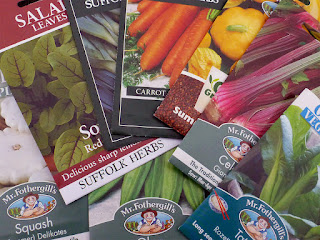Storing Seeds
Many of us will be collecting our seed orders this week so it seems a good time to look at how best to store them. Kept in the right conditions, many seeds will remain viable for several years beyond the ‘use by’ date.
The optimum seed storage area is somewhere cold and dry. At home, we keep our seeds in their original packets, in tightly-lidded tins, on a shaded shelf in a dry garden shed. This seems to work well although it does get rather too warm in the summer. If you don't have a shed or garage then try to keep them in an unheated room in the house. Putting them in a decent storage container - one with a good ‘keep-fresh’ seal - is also important. The idea is to avoid fluctuations in temperature and exclude light and moisture.
Storing your own saved seeds is exactly the same - just make sure they are thoroughly dry before storing them in small air-tight labelled containers (vitamin or pill bottles are good for this).
If you have space in your fridge you can keep your seeds there, but you will have to enclose them in an airtight container and add silica gel regularly to combat humidity. We have never felt the need to go to this much effort and usually manage to use up most of our seeds before they deteriorate to the point where none are viable. For very long-term seed storage you can use the freezer, but this method really isn't necessary for seeds you intend to sow within a few years.
The longer that you keep your seeds the less viable they will be. So, although it's not necessary to throw your seed packets away after a year or two, you will need to sow more seeds each year to ensure that enough germinate for your needs. Some seeds will always last longer than others. Parsnip seeds are notoriously poor after the first year and onion seeds will last about two years, whereas lettuces and tomatoes will carry on for five years or more.
Submitted by Tigger

Comments
Post a Comment